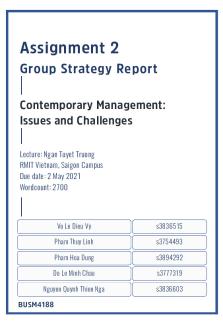Group and team dynamics- sport psychology PDF

| Title | Group and team dynamics- sport psychology |
|---|---|
| Author | Katie Tompkins |
| Course | Exercise and Sports Science |
| Institution | Manchester Metropolitan University |
| Pages | 2 |
| File Size | 63.4 KB |
| File Type | |
| Total Downloads | 78 |
| Total Views | 140 |
Summary
Basic information on team and group dynamics needed for year 1....
Description
Sport Psychology- Group and Team Dynamics Groups and Teams: Carron and Hausenblas and Eys (2005): 1. Common fate 2. Mutual benefit 3. Social structure 4. Members influence and are influenced by others 5. Part of a group and feel members belong there Weinberg and Gould (2014): LINEAR PERSPECTIVE: groups move through four phases: forming, storming, norming and performing (also adjourning- limited life span!) CYCLICAL PERSPECTIVE: life cycle. Groups develop similar to humans. PENDULAR PERSPECTIVE: shifts in personal relationships, during growth or development Group structure: Role: behaviours set that are required of each person Formal- structure of organisation Informal- interactions between group members 3 aspects: 1. Role clarity 2. Role acceptance 3. Role conflict Group Norms: Formal or informal Matt (1965), 4 types: 1. PRESCRIBED: the behaviour appropriate for the group is required 2. PROSCRIBED: expectations not appropriate 3. PERMISSIVE: behaviour permitted, but not required 4. PREFERENCE: behaviour preferred, but not required
How do norms develop? Team interactions: contact between team members Reinforcement: majority of the team find it acceptable Individuals and Team Effectiveness: STEINER’s Theory of Group Productivity Steiner (1972) Groups actual productivity= potential productivity – process losses Process losses: result from faulty coordination or not much motivation from team members Potential productivity: relevant team resources they possess...
Similar Free PDFs

Group dynamics and Team Cohesion
- 9 Pages

Chapter 8 - Team dynamics
- 24 Pages

Sport Psychology Syllabus
- 17 Pages

Sport Psychology-2
- 77 Pages

Topic 2 Sport psychology
- 5 Pages
![[W21] Sport Psychology](https://pdfedu.com/img/crop/172x258/1n2jpeqd4p2q.jpg)
[W21] Sport Psychology
- 3 Pages

Group Dynamics Final Exam
- 5 Pages

Lesson 12 - Group Dynamics
- 3 Pages

Group Assignment FIN202 TEAM 3
- 19 Pages

Group Strategy Report Team 1
- 16 Pages
Popular Institutions
- Tinajero National High School - Annex
- Politeknik Caltex Riau
- Yokohama City University
- SGT University
- University of Al-Qadisiyah
- Divine Word College of Vigan
- Techniek College Rotterdam
- Universidade de Santiago
- Universiti Teknologi MARA Cawangan Johor Kampus Pasir Gudang
- Poltekkes Kemenkes Yogyakarta
- Baguio City National High School
- Colegio san marcos
- preparatoria uno
- Centro de Bachillerato Tecnológico Industrial y de Servicios No. 107
- Dalian Maritime University
- Quang Trung Secondary School
- Colegio Tecnológico en Informática
- Corporación Regional de Educación Superior
- Grupo CEDVA
- Dar Al Uloom University
- Centro de Estudios Preuniversitarios de la Universidad Nacional de Ingeniería
- 上智大学
- Aakash International School, Nuna Majara
- San Felipe Neri Catholic School
- Kang Chiao International School - New Taipei City
- Misamis Occidental National High School
- Institución Educativa Escuela Normal Juan Ladrilleros
- Kolehiyo ng Pantukan
- Batanes State College
- Instituto Continental
- Sekolah Menengah Kejuruan Kesehatan Kaltara (Tarakan)
- Colegio de La Inmaculada Concepcion - Cebu





